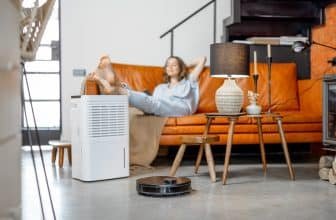Air Purifiers for Smoke: Top Picks for Cleaner Air
Smoke can seriously affect indoor air quality, making it important to find a good air purifier. The best air purifiers for smoke are equipped with True HEPA and activated carbon filters to remove particulate matter and foul odors effectively. Whether from wildfires or indoor smoking, a reliable air purifier can make a huge difference.
Some models are better than others. Budget-friendly options like the Levoit Core 300 cover smaller areas and offer good basic filtration. For larger spaces or more advanced features, consider the Coway Airmega AP-1512HH or the Blueair Blue Pure 211i Max.
Picking the right air purifier involves understanding your needs and the features available. Maintaining your purifier is crucial for long-term efficiency. Informed choices lead to healthier, cleaner air.
Key Takeaways: air purifiers for smoke
- True HEPA and activated carbon filters are essential for effective smoke removal.
- Different purifiers suit different needs and budgets.
- Proper maintenance ensures longevity and effectiveness.
Understanding Air Purifiers and Smoke
Air purifiers for smoke improve indoor air quality by removing particulate matter and volatile organic compounds (VOCs). Here are key considerations around different purifier types, the science of their filters, and how to evaluate their efficiency.
Types of Air Purifiers for Smoke
Different air purifiers cater to various needs. HEPA (High Efficiency Particulate Air) filters are well-known for capturing small particles, making them effective for wildfire smoke and cigarette smoke. Another common type is Activated Carbon Filters, which are superior in removing odors and VOCs. Some models combine these two for comprehensive air cleaning. For example, the Levoit Core 600S offers strong filtration capabilities.
The Science of Filtration: HEPA and Activated Carbon Filters
HEPA Filters trap particles as small as 0.3 microns with 99.97% efficiency, making them effective against smoke particles. They work by forcing air through a fine mesh that captures harmful particles such as pollen, dust mites, and particulate matter. Activated Carbon Filters remove gases and odors by adsorbing VOCs and odors onto their surface area. This makes them essential for removing smoke smells and improving indoor air quality. Models like the Blueair Blue Pure 211 use this technology effectively.
Evaluating Purifier Efficiency: CADR and ACH
Efficiency is often measured by CADR (Clean Air Delivery Rate) and ACH (Air Changes per Hour). CADR rates the volume of filtered air delivered by an air purifier and is measured for smoke, pollen, and dust. Higher CADR numbers indicate better performance. For instance, the Medify MA-112 has a smoke CADR of 500, showing its robustness. ACH indicates how many times an air purifier can clean a room’s air in one hour. Higher ACH means more frequent air turnover, improving air quality faster. Choosing a unit with appropriate CADR and ACH is vital for tackling indoor air quality issues effectively.
Health Benefits and Air Quality Improvement
Air purifiers can significantly enhance health by reducing the presence of harmful particles and contaminants in the air. They are particularly effective in mitigating the adverse effects of smoke, allergens, and other pollutants.
Reducing Health Risks Associated with Various Pollutants
Air purifiers help in removing smoke particles and other pollutants from the air. These devices are designed to capture particles as small as 0.01 microns, which includes many harmful substances.
Smoke from wildfires or cigarettes contains fine particles that can penetrate deep into the lungs, causing respiratory issues. Using an air purifier can reduce exposure to these particles, decreasing the risk of lung diseases and cardiovascular problems.
Pollutants like volatile organic compounds (VOCs) and odors are also effectively eliminated by air purifiers with activated carbon filters. This is essential for maintaining a healthy indoor environment, especially in areas prone to high levels of pollution.
Impact on Asthma, Allergies, and Respiratory Issues
Asthma and allergy sufferers can benefit greatly from air purifiers. These devices remove allergens like pollen, pet dander, and dust mites, which are common triggers for asthma attacks and allergic reactions.
For individuals with respiratory issues, clean air is crucial. Air purifiers can significantly reduce the concentration of irritants that lead to inflammation and discomfort in the respiratory tract.
In environments with high levels of smoke or pollutants, air purifiers can reduce the frequency and severity of asthma attacks. They achieve this by ensuring that the air is free from trigger particles and other airborne irritants.
Using an air purifier can improve overall lung function and make breathing easier for those with chronic respiratory conditions. It creates a safer and healthier living space by continuously filtering out harmful particles.
Selecting the Right Air Purifier for Your Needs
Choosing the best air purifier for smoke removal can be made easier by focusing on room size, key features, and overall costs. Here are some essential tips to help guide your decision.
Considering Room Size and Purifier Coverage Area
When selecting an air purifier, it’s important to match the device to the room size. A unit designed for a smaller area won’t be as effective in a larger space.
For example, the Blue Pure 311i+ Max is suitable for medium to large rooms, while the Levoit Core 300 is ideal for small spaces.
Considering the coverage area ensures the purifier can effectively clean the air in the designated space. Many purifiers will list their square footage coverage on the packaging or product details online.
Key Features and Additional Functions to Look For
Air purifiers come with a variety of features to enhance their performance. One key feature is a HEPA filter, which captures tiny particles, including smoke. The Levoit Core 600S Smart Air Purifier has a HEPA filter and smart capabilities, allowing remote control via smartphone.
Other features to consider include air quality indicators, multiple fan speeds, and automatic shut-off timers. Advanced models, like the Dyson Purifier Cool, may also provide additional functions such as cooling or heating, making them versatile for year-round use.
Price and Long-Term Costs of Ownership
Initial cost is an obvious factor, but ongoing expenses play a significant role too. Consider replacement filters and energy consumption. Budget options, like the Levoit Core 300, may have lower upfront costs but might require frequent filter replacements.
Higher-end models, such as the Coway Airmega AP-1512HH, might have higher initial costs but offer longer-lasting filters and better energy efficiency. Evaluating long-term costs ensures you stay within budget and maintain clean air effectively.
By considering these factors, selecting an air purifier suited to your needs becomes a straightforward process.
Operating and Maintaining Air Purifiers

Proper operation and maintenance are crucial for maximizing the effectiveness and lifespan of your air purifier. Key aspects include regular maintenance, timely filter replacements, and ensuring energy efficiency.
Recommended Maintenance Practices
Regular maintenance helps keep air purifiers running efficiently. Dust and debris can accumulate on external surfaces and vents, reducing airflow. Cleaning the external parts with a damp cloth helps maintain optimal performance.
Check and clean pre-filters regularly as they trap larger particles. Many pre-filters are washable and reusable. Following the manufacturer’s guidelines for each component is essential to avoid damage.
Inspect for any unusual sounds or vibrations, which might indicate a problem. Addressing minor issues promptly can prevent major failures.
Understanding and Managing Filter Replacements
Filters are vital to an air purifier’s function, capturing various pollutants like dust, smoke, and allergens. Most air purifiers use HEPA filters, which need to be replaced every 6 to 12 months, depending on usage and air quality. Carbon filters and other specialized filters may have different replacement schedules.
Monitor the filter indicators, if available, to know when to replace the filter. Using expired filters reduces the purifier’s effectiveness and might recirculate pollutants back into the air.
Purchase compatible filters from the original manufacturer to ensure proper fit and function.
Energy Use and Efficiency
Air purifiers can run continuously or intermittently, affecting energy consumption. Energy-efficient models save on electricity costs without compromising performance.
Look for air purifiers with an Energy Star certification, which indicates higher efficiency.
Operating your air purifier at lower speeds during periods of minimal need can conserve energy. However, running at max settings during high pollution times ensures air quality is maintained.
Choosing a model with a smart sensor can help manage energy use by adjusting the purifier’s operation based on real-time air quality readings. This balance between performance and energy use keeps the environment healthier while being cost-effective.
Advanced Features and Smart Technology
Air purifiers today come with advanced technology to enhance convenience and efficiency. These features include smart apps, voice commands, air quality monitors, auto modes, and sleep modes.
Utilizing Smart Apps and Voice Command
Many modern air purifiers can be controlled through smart apps. This allows users to operate the device remotely, set schedules, and receive notifications. For example, the Levoit Core 600S Smart Air Purifier has an app that lets users adjust settings from their smartphones.
Voice command integration is also common. Devices like the Blueair Blue Pure 211i Max can connect to voice assistants such as Amazon Alexa and Google Assistant. This makes it easy to control the purifier with just your voice.
Monitoring Air Quality with Built-in Sensors
Built-in sensors are a crucial feature of high-end air purifiers. These sensors monitor the air quality in real-time and adjust the purifier’s performance accordingly. The Coway Airmega IconS is one such model that provides continuous feedback on air quality.
These sensors can detect particles like smoke, dust, and pollen. The information collected is often displayed on the purifier’s app or a built-in screen. This helps users understand the quality of air in their home and take action if necessary.
Convenience of Auto and Sleep Modes
Auto mode is designed for efficiency and hassle-free operation. It automatically adjusts the fan speed based on the air quality detected by the sensors. This ensures that the air purifier operates optimally without manual intervention. For instance, the Rabbit Air A3 utilizes a sophisticated auto mode to maintain clean air.
Sleep mode, on the other hand, is perfect for nighttime use. It reduces noise levels and dims display lights, allowing for a restful sleep. Models like the Toshiba Air Purifier are known for their quiet operation in sleep mode, making them ideal for bedrooms.
Frequently Asked Questions
An effective air purifier for smoke often includes a HEPA filter, activated carbon, and regular maintenance. These features improve air quality by removing particles and odors from both cigarette and wildfire smoke.
What is the most effective air purifier for removing cigarette smoke from indoor air?
The best air purifier for cigarette smoke combines a HEPA filter and activated carbon. The Blue Pure 311i+ Max is a top choice due to its efficiency in capturing smoke particles.
How do HEPA filters perform in air purifiers when it comes to smoke particles?
HEPA filters are effective at removing smoke particles because they capture particles as small as 0.3 microns. This makes them capable of filtering nearly all smoke particles out of the air.
What features should I look for in an air purifier to combat smoke contamination?
Seek out air purifiers with HEPA filters and activated carbon. Also, check for a high Clean Air Delivery Rate (CADR) for smoke. A high CADR ensures that the purifier can process a lot of air quickly, enhancing its effectiveness against smoke.
Do air purifiers help in eliminating the odor associated with smoke?
Yes, air purifiers with activated carbon are best for removing smoke odors. Activated carbon traps odor molecules, reducing unpleasant smells in the indoor environment.
Can air purifiers handle both wildfire smoke and cigarette smoke effectively?
Air purifiers, especially those with HEPA filters and activated carbon, are effective against both wildfire smoke and cigarette smoke. For instance, the Blueair Blue Pure 211+ Auto is recommended for fast filtering of various smoke types.
How often should filters be replaced in air purifiers that are used for smoke?
Filters in air purifiers should be replaced every 6 to 12 months, depending on usage and smoke levels. HEPA filters may need frequent changing if the air purifier is used in environments with constant smoke exposure.
best air purifiers
My name is Philipp Walz, editor at best-air-purifiers.com, and I’m truly passionate about creating healthier living spaces through smart, effective air purification. For me, air purifiers aren’t just appliances – they’re a quiet revolution in how we breathe, live, and feel at home. Clean air means better sleep, clearer thinking, and fewer allergies. It’s about giving our bodies what they need most: pure, fresh air. I’ve experienced firsthand how the right air purifier can transform a space and improve well-being – and I’m here to help others discover that difference. Because when you breathe better, you live better.






